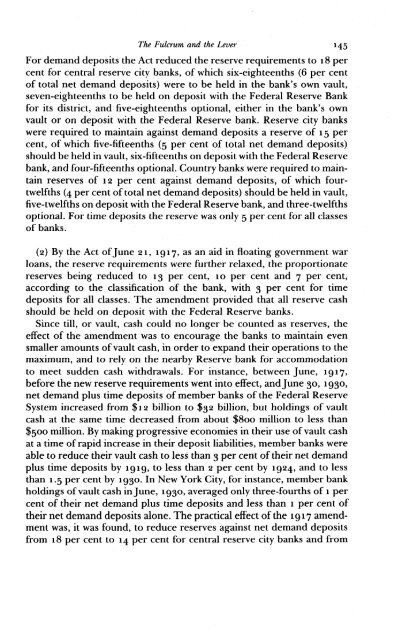You also want an ePaper? Increase the reach of your titles
YUMPU automatically turns print PDFs into web optimized ePapers that Google loves.
The Fulcrum and the Lever 145<br />
For demand deposits the Act reduced the reserve requirements to 18 per<br />
cent for central reserve city banks, of which six-eighteenths (6 per cent<br />
of total net demand deposits) were to be held in the bank's own vault,<br />
seven-eighteenths to be held on deposit with the Federal Reserve Bank<br />
for its district, and five-eighteenths optional, either in the bank's own<br />
vault or on deposit with the Federal Reserve bank. Reserve city banks<br />
were required to maintain against demand deposits a reserve of 15 per<br />
cent, of which five-fifteenths (5 per cent of total net demand deposits)<br />
should be held in vault, six-fifteenths on deposit with the Federal Reserve<br />
bank, and four-fifteenths optional. Country banks were required to maintain<br />
reserves of 12 per cent against demand deposits, of which fourtwelfths<br />
(4 per cent oftotal net demand deposits) should be held in vault,<br />
five-twelfths on deposit with the Federal Reserve bank, and three-twelfths<br />
optional. For time deposits the reserve was only 5 per cent for all classes<br />
of banks.<br />
(2) By the Act ofJune 21, 1917, as an aid in floating government war<br />
loans, the reserve requirements were further relaxed, the proportionate<br />
reserves being reduced to 13 per cent, 10 per cent and 7 per cent,<br />
according to the classification of the bank, with 3 per cent for time<br />
deposits for all classes. The amendment provided that all reserve cash<br />
should be held on deposit with the Federal Reserve banks.<br />
Since till, or vault, cash could no longer be counted as reserves, the<br />
effect of the amendment was to encourage the banks to maintain even<br />
smaller amounts ofvault cash, in order to expand their operations to the<br />
maximum, and to rely on the nearby Reserve bank for accommodation<br />
to meet sudden cash withdrawals. For instance, between June, 1917,<br />
before the new reserve requirements went into effect, andJune 30, 1930,<br />
net demand plus time deposits ofmember banks of the Federal Reserve<br />
System increased from $12 billion to $32 billion, but holdings of vault<br />
cash at the same time decreased from about $800 million to less than<br />
$500 million. By making progressive economies in their use ofvault cash<br />
at a time ofrapid increase in their deposit liabilities, member banks were<br />
able to reduce their vault cash to less than 3 per cent oftheir net demand<br />
plus time deposits by 1919, to less than 2 per cent by 1924, and to less<br />
than 1.5 per cent by 1930. In New York City, for instance, member bank<br />
holdings ofvault cash inJune, 1930, averaged only three-fourths of 1 per<br />
cent of their net demand plus time deposits and less than 1 per cent of<br />
their net demand deposits alone. The practical effect ofthe 1917 amendment<br />
was, it was found, to reduce reserves against net demand deposits<br />
from 18 per cent to 14 per cent for central reserve city banks and from

















